Abstract
The mouse mdr2gene (and its human homologue MDR3, also called MDR2) encodes a P-glycoprotein that is present in high concentration in the bile canalicular membrane of hepatocytes. The 129/OlaHsd mice with a homozygous disruption of the mdr2 gene (-/-mice) lack this P-glycoprotein in the canalicular membrane. These mice are unable to secrete phospholipids into bile, showing an essential role for the mdr2 P-glycoprotein in the transport of phosphatidylcholine across the canalicular membrane. The complete absence of phospholipids from bile leads to a hepatic disease, which becomes manifest shortly after birth and shows progression to an end stage in the course of 3 months. The liver pathology is that of a nonsuppurative inflammatory cholangitis with portal inflammation and ductular proliferation, consistent with toxic in-jury of the biliary system from bile salts unaccompanied by phospholipids. Thus, the mdr2 (-/-) mice can serve as an animal model for studying mechanisms and potential interventions in nonsuppurative inflammatory cholangitis (in a generic sense) in human disease, be it congenital or acquired. When the mice are 4 to 6 months of age, preneoplastic lesions develop in the liver, progressing to metastatic liver cancer in the terminal phase. The mdr2 (-/-) mice therefore also provide a tumor progression model of value for the study of hepatic carcinogenesis. Interestingly, also in this regard, the model mimicks human disease, because chronic inflammation of the biliary system in humans may similarly carry increased cancer risk.
Full text
PDF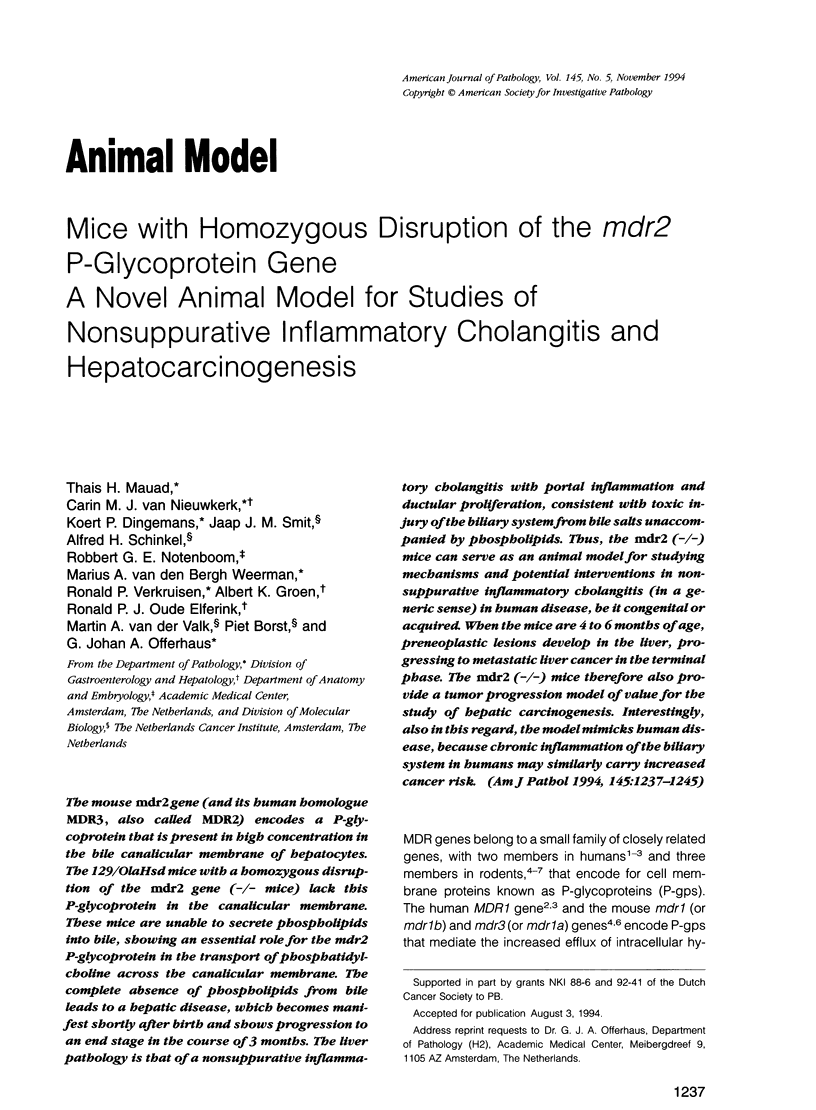
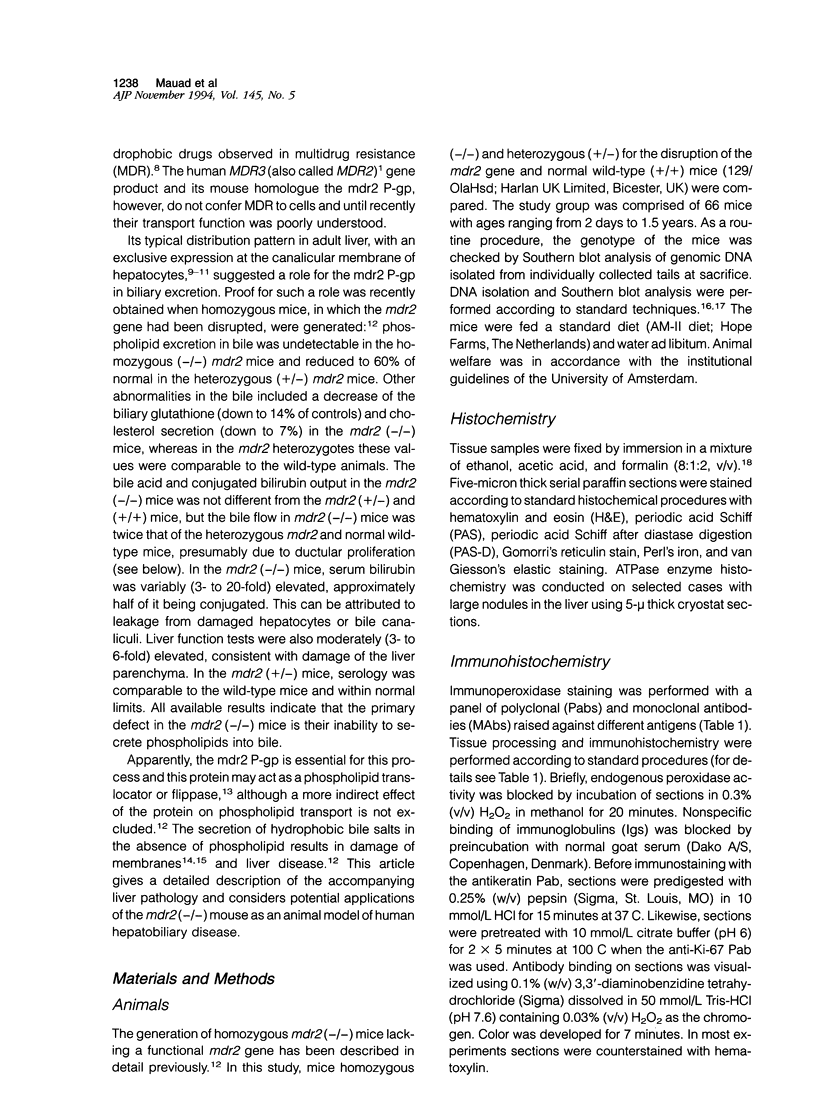
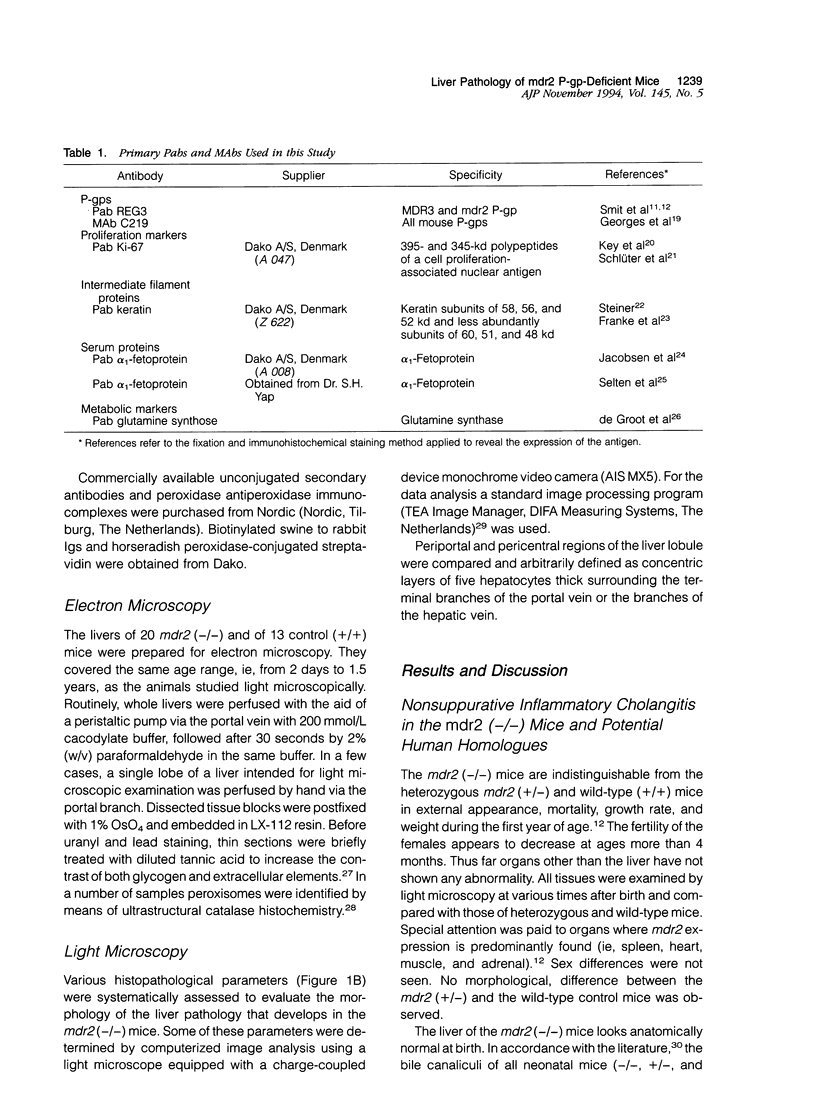
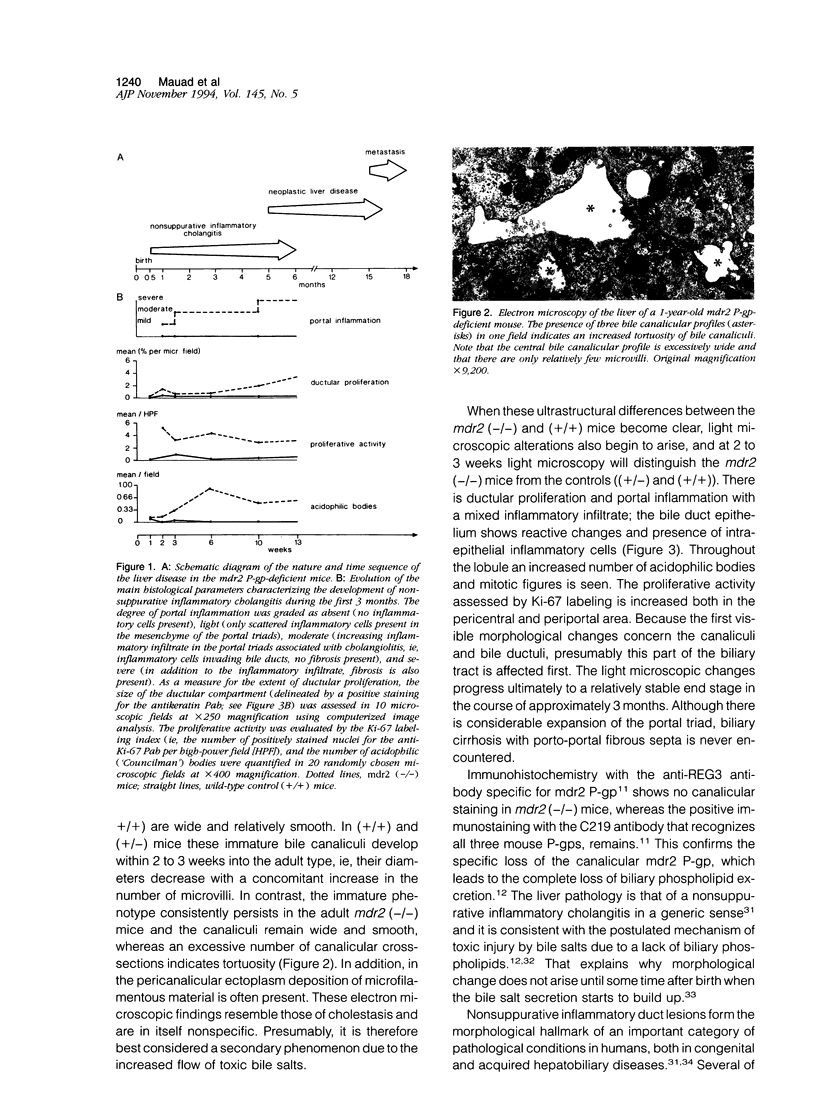
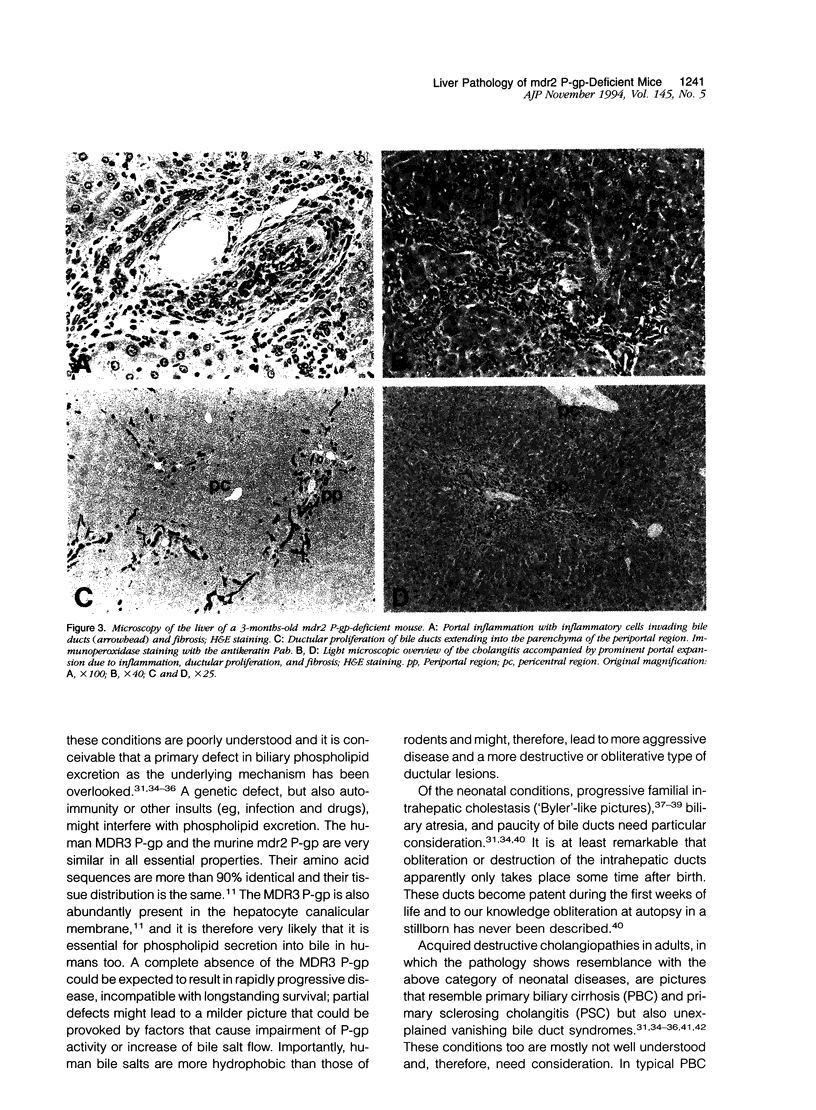
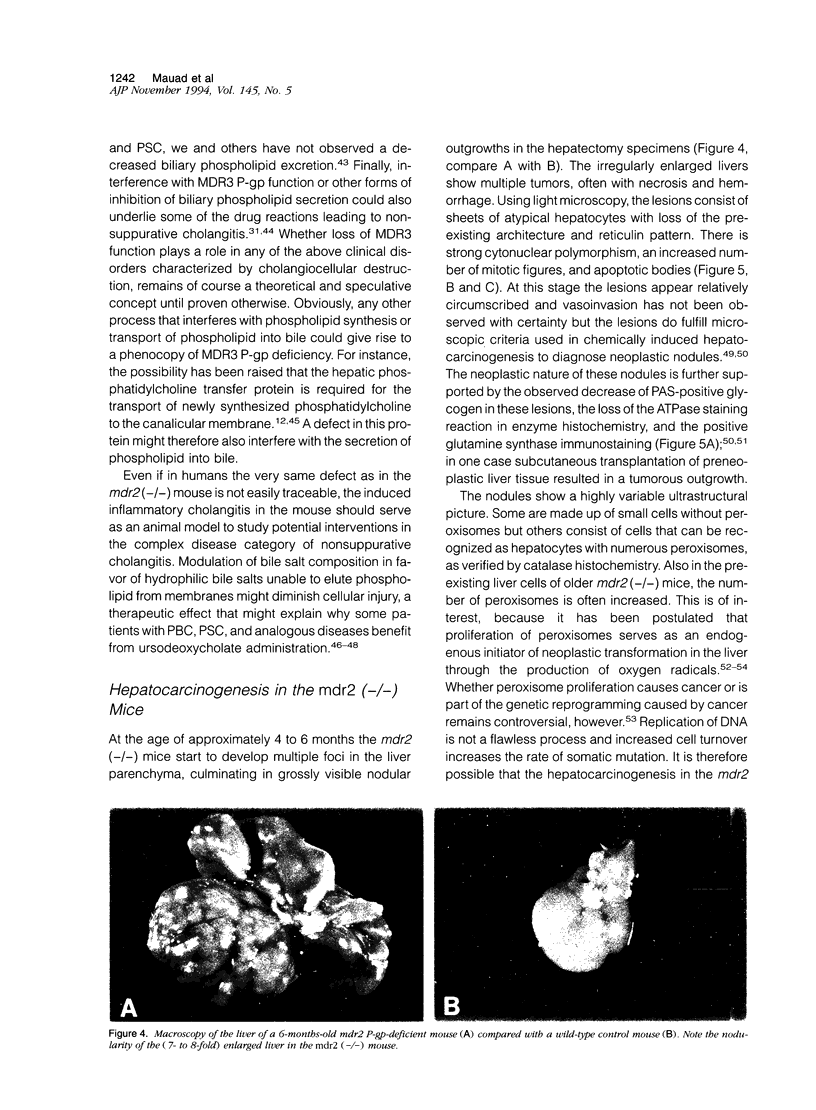
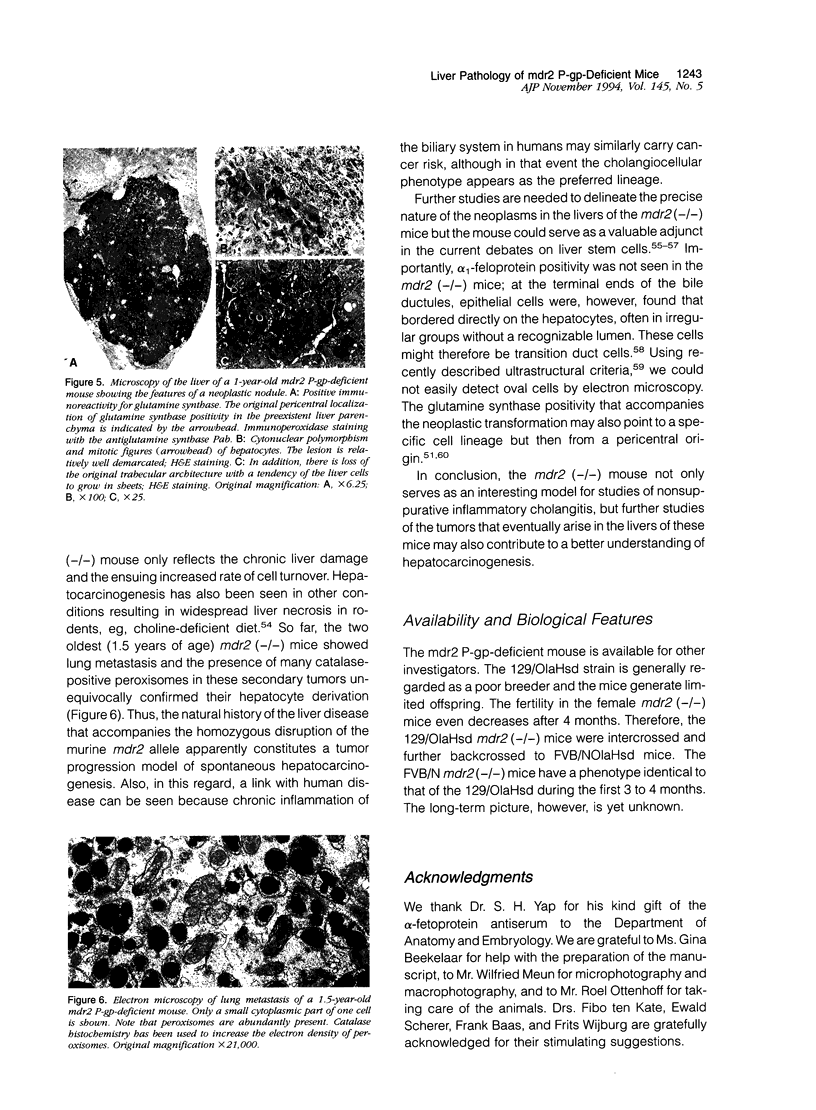
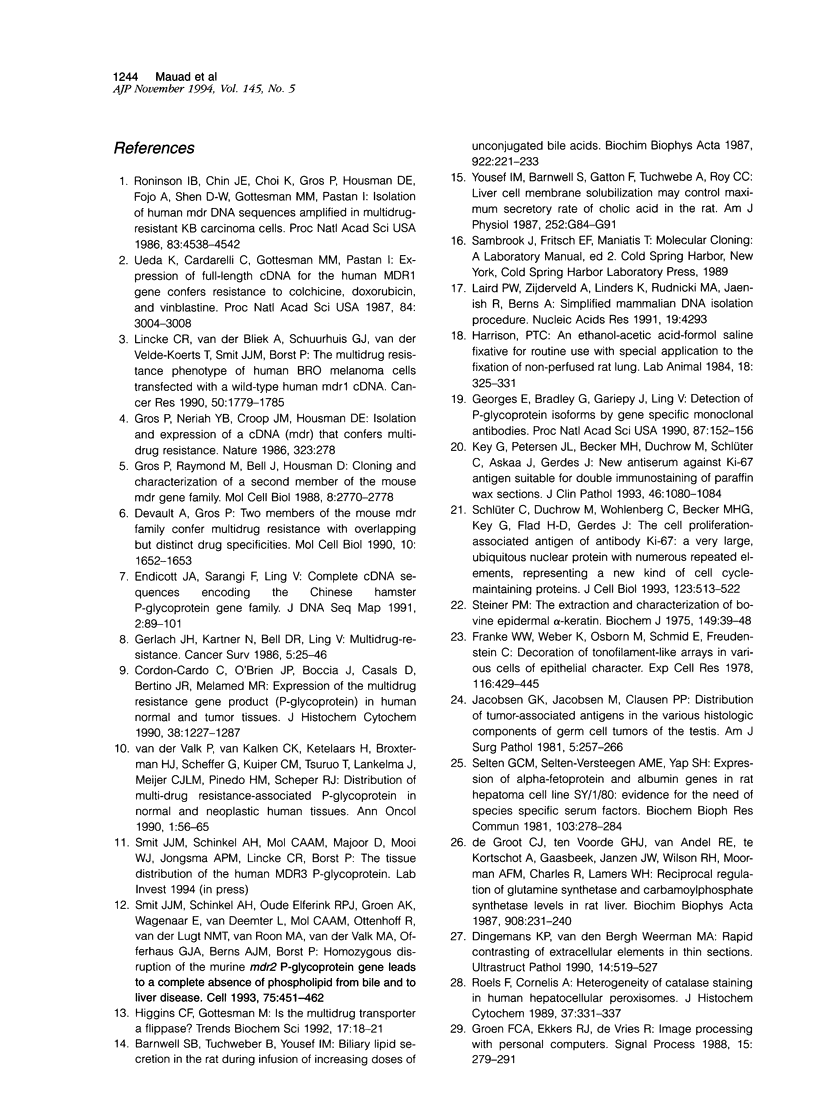
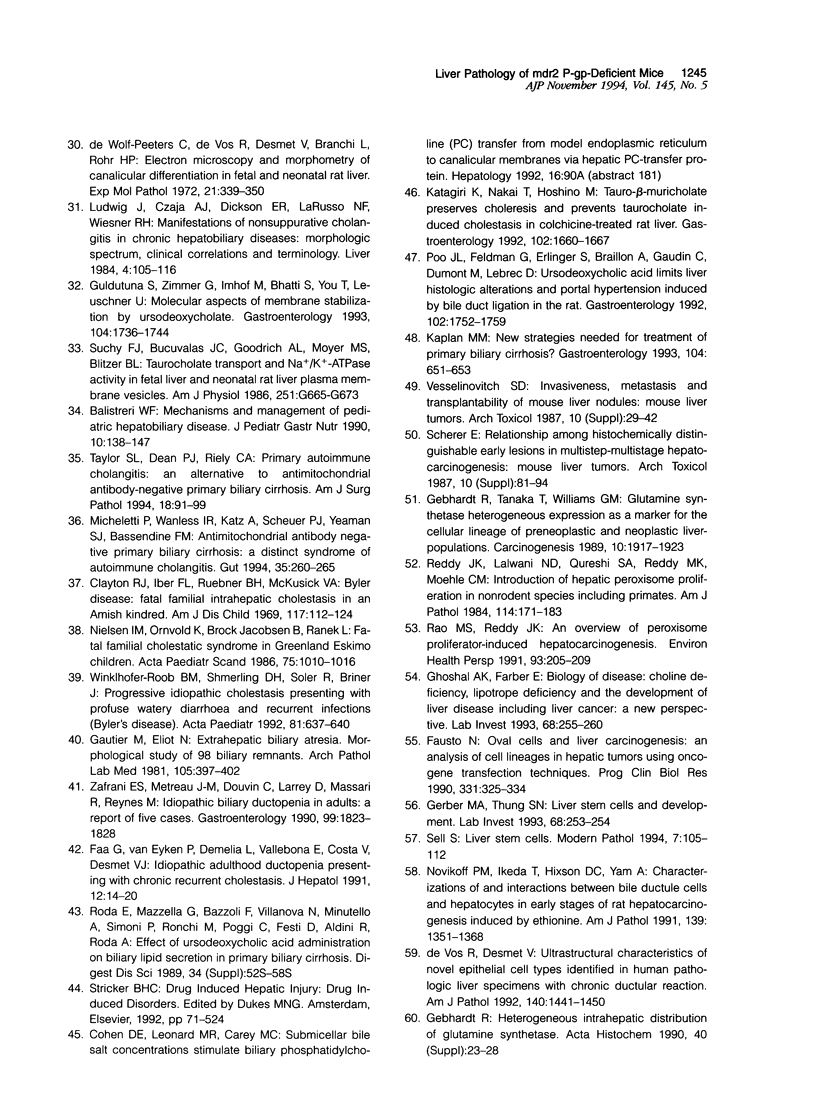
Images in this article
Selected References
These references are in PubMed. This may not be the complete list of references from this article.
- Barnwell S. G., Tuchweber B., Yousef I. M. Biliary lipid secretion in the rat during infusion of increasing doses of unconjugated bile acids. Biochim Biophys Acta. 1987 Nov 21;922(2):221–233. doi: 10.1016/0005-2760(87)90158-5. [DOI] [PubMed] [Google Scholar]
- Carroll S. B., Winslow G. M., Schüpbach T., Scott M. P. Maternal control of Drosophila segmentation gene expression. Nature. 1986 Sep 18;323(6085):278–280. doi: 10.1038/323278a0. [DOI] [PubMed] [Google Scholar]
- Clayton R. J., Iber F. L., Ruebner B. H., McKusick V. A. Byler disease. Fatal familial intrahepatic cholestasis in an Amish kindred. Am J Dis Child. 1969 Jan;117(1):112–124. [PubMed] [Google Scholar]
- Cordon-Cardo C., O'Brien J. P., Boccia J., Casals D., Bertino J. R., Melamed M. R. Expression of the multidrug resistance gene product (P-glycoprotein) in human normal and tumor tissues. J Histochem Cytochem. 1990 Sep;38(9):1277–1287. doi: 10.1177/38.9.1974900. [DOI] [PubMed] [Google Scholar]
- De Vos R., Desmet V. Ultrastructural characteristics of novel epithelial cell types identified in human pathologic liver specimens with chronic ductular reaction. Am J Pathol. 1992 Jun;140(6):1441–1450. [PMC free article] [PubMed] [Google Scholar]
- De Wolf-Peeters C., De Vos R., Desmet V., Bianchi L., Rohr H. P. Electron microscopy and morphometry of canalicular differentiation in fetal and neonatal rat liver. Exp Mol Pathol. 1974 Dec;21(3):339–350. doi: 10.1016/0014-4800(74)90100-2. [DOI] [PubMed] [Google Scholar]
- Devault A., Gros P. Two members of the mouse mdr gene family confer multidrug resistance with overlapping but distinct drug specificities. Mol Cell Biol. 1990 Apr;10(4):1652–1663. doi: 10.1128/mcb.10.4.1652. [DOI] [PMC free article] [PubMed] [Google Scholar]
- Dingemans K. P., van den Bergh Weerman M. A. Rapid contrasting of extracellular elements in thin sections. Ultrastruct Pathol. 1990 Nov-Dec;14(6):519–527. doi: 10.3109/01913129009076139. [DOI] [PubMed] [Google Scholar]
- Endicott J. A., Sarangi F., Ling V. Complete cDNA sequences encoding the Chinese hamster P-glycoprotein gene family. DNA Seq. 1991;2(2):89–101. doi: 10.3109/10425179109039677. [DOI] [PubMed] [Google Scholar]
- Faa G., Van Eyken P., Demelia L., Vallebona E., Costa V., Desmet V. J. Idiopathic adulthood ductopenia presenting with chronic recurrent cholestasis. A case report. J Hepatol. 1991 Jan;12(1):14–20. doi: 10.1016/0168-8278(91)90902-n. [DOI] [PubMed] [Google Scholar]
- Fausto N. Oval cells and liver carcinogenesis: an analysis of cell lineages in hepatic tumors using oncogene transfection techniques. Prog Clin Biol Res. 1990;331:325–334. [PubMed] [Google Scholar]
- Franke W. W., Weber K., Osborn M., Schmid E., Freudenstein C. Antibody to prekeratin. Decoration of tonofilament like arrays in various cells of epithelial character. Exp Cell Res. 1978 Oct 15;116(2):429–445. doi: 10.1016/0014-4827(78)90466-4. [DOI] [PubMed] [Google Scholar]
- Gautier M., Eliot N. Extrahepatic biliary atresia. Morphological study of 98 biliary remnants. Arch Pathol Lab Med. 1981 Aug;105(8):397–402. [PubMed] [Google Scholar]
- Gebhardt R. Heterogeneous intrahepatic distribution of glutamine synthetase. Acta Histochem Suppl. 1990;40:23–28. [PubMed] [Google Scholar]
- Gebhardt R., Tanaka T., Williams G. M. Glutamine synthetase heterogeneous expression as a marker for the cellular lineage of preneoplastic and neoplastic liver populations. Carcinogenesis. 1989 Oct;10(10):1917–1923. doi: 10.1093/carcin/10.10.1917. [DOI] [PubMed] [Google Scholar]
- Georges E., Bradley G., Gariepy J., Ling V. Detection of P-glycoprotein isoforms by gene-specific monoclonal antibodies. Proc Natl Acad Sci U S A. 1990 Jan;87(1):152–156. doi: 10.1073/pnas.87.1.152. [DOI] [PMC free article] [PubMed] [Google Scholar]
- Gerber M. A., Thung S. N. Liver stem cells and development. Lab Invest. 1993 Mar;68(3):253–254. [PubMed] [Google Scholar]
- Gerlach J. H., Kartner N., Bell D. R., Ling V. Multidrug resistance. Cancer Surv. 1986;5(1):25–46. [PubMed] [Google Scholar]
- Ghoshal A. K., Farber E. Choline deficiency, lipotrope deficiency and the development of liver disease including liver cancer: a new perspective. Lab Invest. 1993 Mar;68(3):255–260. [PubMed] [Google Scholar]
- Gros P., Raymond M., Bell J., Housman D. Cloning and characterization of a second member of the mouse mdr gene family. Mol Cell Biol. 1988 Jul;8(7):2770–2778. doi: 10.1128/mcb.8.7.2770. [DOI] [PMC free article] [PubMed] [Google Scholar]
- Güldütuna S., Zimmer G., Imhof M., Bhatti S., You T., Leuschner U. Molecular aspects of membrane stabilization by ursodeoxycholate [see comment]. Gastroenterology. 1993 Jun;104(6):1736–1744. doi: 10.1016/0016-5085(93)90653-t. [DOI] [PubMed] [Google Scholar]
- Harrison P. T. An ethanol-acetic acid-formol saline fixative for routine use with special application to the fixation of non-perfused rat lung. Lab Anim. 1984 Oct;18(4):325–331. doi: 10.1258/002367784780865324. [DOI] [PubMed] [Google Scholar]
- Higgins C. F., Gottesman M. M. Is the multidrug transporter a flippase? Trends Biochem Sci. 1992 Jan;17(1):18–21. doi: 10.1016/0968-0004(92)90419-a. [DOI] [PubMed] [Google Scholar]
- Jacobsen G. K., Jacobsen M., Clausen P. P. Distribution of tumor-associated antigens in the various histologic components of germ cell tumors of the testis. Am J Surg Pathol. 1981 Apr;5(3):257–266. doi: 10.1097/00000478-198104000-00006. [DOI] [PubMed] [Google Scholar]
- Kaplan M. M. New strategies needed for treatment of primary biliary cirrhosis? Gastroenterology. 1993 Feb;104(2):651–653. doi: 10.1016/0016-5085(93)90440-n. [DOI] [PubMed] [Google Scholar]
- Katagiri K., Nakai T., Hoshino M., Hayakawa T., Ohnishi H., Okayama Y., Yamada T., Ohiwa T., Miyaji M., Takeuchi T. Tauro-beta-muricholate preserves choleresis and prevents taurocholate-induced cholestasis in colchicine-treated rat liver. Gastroenterology. 1992 May;102(5):1660–1667. doi: 10.1016/0016-5085(92)91727-l. [DOI] [PubMed] [Google Scholar]
- Key G., Petersen J. L., Becker M. H., Duchrow M., Schlüter C., Askaa J., Gerdes J. New antiserum against Ki-67 antigen suitable for double immunostaining of paraffin wax sections. J Clin Pathol. 1993 Dec;46(12):1080–1084. doi: 10.1136/jcp.46.12.1080. [DOI] [PMC free article] [PubMed] [Google Scholar]
- Laird P. W., Zijderveld A., Linders K., Rudnicki M. A., Jaenisch R., Berns A. Simplified mammalian DNA isolation procedure. Nucleic Acids Res. 1991 Aug 11;19(15):4293–4293. doi: 10.1093/nar/19.15.4293. [DOI] [PMC free article] [PubMed] [Google Scholar]
- Lincke C. R., van der Bliek A. M., Schuurhuis G. J., van der Velde-Koerts T., Smit J. J., Borst P. Multidrug resistance phenotype of human BRO melanoma cells transfected with a wild-type human mdr1 complementary DNA. Cancer Res. 1990 Mar 15;50(6):1779–1785. [PubMed] [Google Scholar]
- Ludwig J., Czaja A. J., Dickson E. R., LaRusso N. F., Wiesner R. H. Manifestations of nonsuppurative cholangitis in chronic hepatobiliary diseases: morphologic spectrum, clinical correlations and terminology. Liver. 1984 Apr;4(2):105–116. doi: 10.1111/j.1600-0676.1984.tb00914.x. [DOI] [PubMed] [Google Scholar]
- Michieletti P., Wanless I. R., Katz A., Scheuer P. J., Yeaman S. J., Bassendine M. F., Palmer J. M., Heathcote E. J. Antimitochondrial antibody negative primary biliary cirrhosis: a distinct syndrome of autoimmune cholangitis. Gut. 1994 Feb;35(2):260–265. doi: 10.1136/gut.35.2.260. [DOI] [PMC free article] [PubMed] [Google Scholar]
- Nielsen I. M., Ornvold K., Jacobsen B. B., Ranek L. Fatal familial cholestatic syndrome in Greenland Eskimo children. Acta Paediatr Scand. 1986 Nov;75(6):1010–1016. doi: 10.1111/j.1651-2227.1986.tb10332.x. [DOI] [PubMed] [Google Scholar]
- Novikoff P. M., Ikeda T., Hixson D. C., Yam A. Characterizations of and interactions between bile ductule cells and hepatocytes in early stages of rat hepatocarcinogenesis induced by ethionine. Am J Pathol. 1991 Dec;139(6):1351–1368. [PMC free article] [PubMed] [Google Scholar]
- Poo J. L., Feldmann G., Erlinger S., Braillon A., Gaudin C., Dumont M., Lebrec D. Ursodeoxycholic acid limits liver histologic alterations and portal hypertension induced by bile duct ligation in the rat. Gastroenterology. 1992 May;102(5):1752–1759. doi: 10.1016/0016-5085(92)91739-q. [DOI] [PubMed] [Google Scholar]
- Rao M. S., Reddy J. K. An overview of peroxisome proliferator-induced hepatocarcinogenesis. Environ Health Perspect. 1991 Jun;93:205–209. doi: 10.1289/ehp.9193205. [DOI] [PMC free article] [PubMed] [Google Scholar]
- Reddy J. K., Lalwani N. D., Qureshi S. A., Reddy M. K., Moehle C. M. Induction of hepatic peroxisome proliferation in nonrodent species, including primates. Am J Pathol. 1984 Jan;114(1):171–183. [PMC free article] [PubMed] [Google Scholar]
- Roda E., Mazzella G., Bazzoli F., Villanova N., Minutello A., Simoni P., Ronchi M., Poggi C., Festi D., Aldini R. Effect of ursodeoxycholic acid administration on biliary lipid secretion in primary biliary cirrhosis. Dig Dis Sci. 1989 Dec;34(12 Suppl):52S–58S. doi: 10.1007/BF01536664. [DOI] [PubMed] [Google Scholar]
- Roels F., Cornelis A. Heterogeneity of catalase staining in human hepatocellular peroxisomes. J Histochem Cytochem. 1989 Mar;37(3):331–337. doi: 10.1177/37.3.2918222. [DOI] [PubMed] [Google Scholar]
- Roninson I. B., Chin J. E., Choi K. G., Gros P., Housman D. E., Fojo A., Shen D. W., Gottesman M. M., Pastan I. Isolation of human mdr DNA sequences amplified in multidrug-resistant KB carcinoma cells. Proc Natl Acad Sci U S A. 1986 Jun;83(12):4538–4542. doi: 10.1073/pnas.83.12.4538. [DOI] [PMC free article] [PubMed] [Google Scholar]
- Scherer E. Relationship among histochemically distinguishable early lesions in multistep-multistage hepatocarcinogenesis. Arch Toxicol Suppl. 1987;10:81–94. doi: 10.1007/978-3-642-71617-1_7. [DOI] [PubMed] [Google Scholar]
- Schlüter C., Duchrow M., Wohlenberg C., Becker M. H., Key G., Flad H. D., Gerdes J. The cell proliferation-associated antigen of antibody Ki-67: a very large, ubiquitous nuclear protein with numerous repeated elements, representing a new kind of cell cycle-maintaining proteins. J Cell Biol. 1993 Nov;123(3):513–522. doi: 10.1083/jcb.123.3.513. [DOI] [PMC free article] [PubMed] [Google Scholar]
- Selten G. C., Selten-Versteegen A. M., Yap S. H. Expression of alpha-fetoprotein and albumin genes in a rat hepatoma cell line SY/1/80: evidence for the need of species specific serum factors. Biochem Biophys Res Commun. 1981 Nov 16;103(1):278–284. doi: 10.1016/0006-291x(81)91690-9. [DOI] [PubMed] [Google Scholar]
- Smit J. J., Schinkel A. H., Oude Elferink R. P., Groen A. K., Wagenaar E., van Deemter L., Mol C. A., Ottenhoff R., van der Lugt N. M., van Roon M. A. Homozygous disruption of the murine mdr2 P-glycoprotein gene leads to a complete absence of phospholipid from bile and to liver disease. Cell. 1993 Nov 5;75(3):451–462. doi: 10.1016/0092-8674(93)90380-9. [DOI] [PubMed] [Google Scholar]
- Steinert P. M. The extraction and characterization of bovine epidermal alpha-keratin. Biochem J. 1975 Jul;149(1):39–48. doi: 10.1042/bj1490039. [DOI] [PMC free article] [PubMed] [Google Scholar]
- Suchy F. J., Bucuvalas J. C., Goodrich A. L., Moyer M. S., Blitzer B. L. Taurocholate transport and Na+-K+-ATPase activity in fetal and neonatal rat liver plasma membrane vesicles. Am J Physiol. 1986 Nov;251(5 Pt 1):G665–G673. doi: 10.1152/ajpgi.1986.251.5.G665. [DOI] [PubMed] [Google Scholar]
- Taylor S. L., Dean P. J., Riely C. A. Primary autoimmune cholangitis. An alternative to antimitochondrial antibody-negative primary biliary cirrhosis. Am J Surg Pathol. 1994 Jan;18(1):91–99. [PubMed] [Google Scholar]
- Ueda K., Cardarelli C., Gottesman M. M., Pastan I. Expression of a full-length cDNA for the human "MDR1" gene confers resistance to colchicine, doxorubicin, and vinblastine. Proc Natl Acad Sci U S A. 1987 May;84(9):3004–3008. doi: 10.1073/pnas.84.9.3004. [DOI] [PMC free article] [PubMed] [Google Scholar]
- Vesselinovitch S. D. Invasiveness, metastasis, and transplantability of mouse liver nodules. Arch Toxicol Suppl. 1987;10:29–42. doi: 10.1007/978-3-642-71617-1_3. [DOI] [PubMed] [Google Scholar]
- Winklhofer-Roob B. M., Shmerling D. H., Solèr R., Briner J. Progressive idiopathic cholestasis presenting with profuse watery diarrhoea and recurrent infections (Byler's disease). Acta Paediatr. 1992 Aug;81(8):637–640. doi: 10.1111/j.1651-2227.1992.tb12320.x. [DOI] [PubMed] [Google Scholar]
- Yousef I. M., Barnwell S., Gratton F., Tuchweber B., Weber A., Roy C. C. Liver cell membrane solubilization may control maximum secretory rate of cholic acid in the rat. Am J Physiol. 1987 Jan;252(1 Pt 1):G84–G91. doi: 10.1152/ajpgi.1987.252.1.G84. [DOI] [PubMed] [Google Scholar]
- Zafrani E. S., Metreau J. M., Douvin C., Larrey D., Massari R., Reynes M., Doffoel M., Benhamou J. P., Dhumeaux D. Idiopathic biliary ductopenia in adults: a report of five cases. Gastroenterology. 1990 Dec;99(6):1823–1828. doi: 10.1016/0016-5085(90)90494-l. [DOI] [PubMed] [Google Scholar]
- de Groot C. J., ten Voorde G. H., van Andel R. E., te Kortschot A., Gaasbeek Janzen J. W., Wilson R. H., Moorman A. F., Charles R., Lamers W. H. Reciprocal regulation of glutamine synthetase and carbamoylphosphate synthetase levels in rat liver. Biochim Biophys Acta. 1987 Apr 29;908(3):231–240. doi: 10.1016/0167-4781(87)90103-5. [DOI] [PubMed] [Google Scholar]
- van der Valk P., van Kalken C. K., Ketelaars H., Broxterman H. J., Scheffer G., Kuiper C. M., Tsuruo T., Lankelma J., Meijer C. J., Pinedo H. M. Distribution of multi-drug resistance-associated P-glycoprotein in normal and neoplastic human tissues. Analysis with 3 monoclonal antibodies recognizing different epitopes of the P-glycoprotein molecule. Ann Oncol. 1990;1(1):56–64. [PubMed] [Google Scholar]







